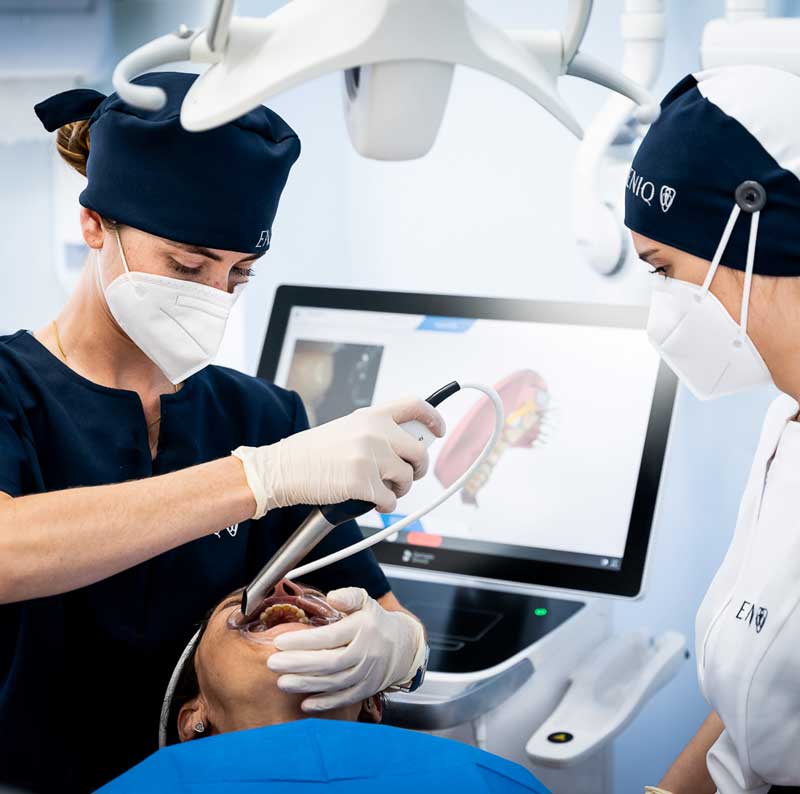

Dental Splint
Relieve bruxism with custom-made occlusal splints at ENIQ.
What is an Occlusal Splint?
Bruxism is a functional disorder characterized by grinding, crunching, or clenching teeth unconsciously. It can affect all types of people, being more common in adults. In fact, it is estimated that about 70% of the adult population suffers from bruxism. Although its causes are not fully known, stress and sleep disorders are the main causes of bruxism. Also known as a silent disease, it can cause headache, jaw pain, and ear pain, as well as dental problems such as wear.
The causes of bruxism are varied and can combine different physical, psychological, and genetic factors. Although not known exactly, the most common trigger is stress. Other causes of bruxism include anxiety, depression, and the consumption of alcohol or drugs. Also, bruxism is related to dental malocclusion and sleep disorders like obstructive sleep apnea syndrome.
Bruxism treatments help to prevent its consequences. If we fail to relax the jaw, some of the consequences we can suffer:
- Dental wear that mainly affects dental sensitivity, as well as fracture or loss of teeth.
- Jaw pain caused by the muscle tension exerted.
- Headache, also generated by muscle tension, affecting the temporal and posterior area of the head.
- Sleep quality problems, as it can interrupt the person's sleep.
- Problems of the temporomandibular joint causing clicking when opening and closing the mouth, facial pain, and difficulty eating or speaking.
Therefore, muscle relaxation treatments for bruxism can improve the quality of life of those who suffer from it.
An occlusal splint is a dental device used to treat and prevent various disorders related to the temporomandibular joint (TMJ), the jaw muscles, and teeth. It is also known as an occlusal plate, occlusal guard, interocclusal splint, or simply a splint.
The occlusal splint is a personalized appliance that is placed in the mouth and covers the upper or lower teeth, or both, depending on the patient's need. Its main goal is to provide adequate support to the jaw joint and relieve tension in the jaw muscles.
Occlusal splints are used for a variety of purposes, including:
- Treatment of TMJ disorders: They help reduce symptoms of temporomandibular disorders, such as jaw pain, clicking or crepitation of the joint, limitation of mouth opening, and jaw locking.
- Teeth protection: Occlusal splints are used as dental guards to prevent excessive wear of the teeth due to bruxism (teeth grinding) or involuntary jaw clenching.
- Muscle pain relief: They help relax the jaw muscles and reduce muscle tension, which can alleviate facial and headache pain associated with TMJ disorders.
- Bite correction: In some cases, occlusal splints can also be used to correct bite problems, such as malocclusion or dental misalignment.
Occlusal splints are usually custom-made by a dentist or a TMJ disorder specialist. The manufacturing process involves taking impressions of the patient's teeth and jaw to create a splint that fits correctly and provides adequate support.
It's important to highlight that the use of an occlusal splint should be supervised by a dental health professional, who will determine the need for this device and provide instructions on its proper use and maintenance.
Procedure
What is the procedure for making an occlusal splint?
The process for creating an occlusal splint involves an initial evaluation, taking dental impressions, bite registration, custom design, and laboratory fabrication. Then, it is carefully adjusted to ensure comfort and proper alignment. Finally, instructions for its use and maintenance are provided, followed by follow-up to assess its effectiveness and make adjustments if necessary. This procedure is adapted for each patient for precise and effective treatment.

Procedure for making an occlusal splint:
- Evaluation and diagnosis: Firstly, a dental evaluation and an assessment of the temporomandibular joint (TMJ) are conducted by a dentist or TMJ disorder specialist. This includes a review of the patient's symptoms, a dental examination, and an occlusion evaluation (how the upper and lower teeth fit together).
- Taking impressions: Once the diagnosis is made, impressions of the patient's upper and lower teeth are taken. This is done using an impression material that is placed in the mouth and held for a few minutes until it hardens and an accurate impression of the teeth and oral structures is obtained.
- Bite registration: The bite relationship between the upper and lower teeth is recorded using a bite registration material. This is done to ensure that the splint fits correctly and provides an appropriate jaw position.
- Design and fabrication of the splint: With the impressions and bite registration, the custom-designed occlusal splint is then fabricated. This is done in a dental laboratory using durable materials like acrylic, which are molded and adjusted according to the patient's specifications.
- Fitting and placement: Once the occlusal splint has been fabricated, a careful fitting is done to ensure it comfortably fits in the patient's mouth. The dentist or specialist makes necessary adjustments to ensure proper placement and balanced occlusion.
- Usage instructions and follow-up: Instructions are provided to the patient on how to use and care for the occlusal splint. This includes information on the duration of use, proper cleaning, and necessary care. Follow-up appointments are also scheduled to assess the patient's progress and make any additional adjustments if necessary.
It is important to note that the availability of digital anesthesia may vary depending on the dental office and geographical location. If you are interested in this type of anesthesia, I would recommend talking to your dentist to determine if they offer this service and if it is appropriate for your specific case.
+70%
What is the success rate of the occlusal splint?
The success rate of the occlusal splint can vary depending on various factors, such as the underlying cause of bruxism or TMJ disorder, the severity of the problem, the patient's adherence to the use of the splint, and the precision of the fit and design of the splint.
In general, the occlusal splint is considered an effective treatment for managing bruxism and some TMJ disorders. It is estimated that around 70% to 80% of patients experience a significant reduction in symptoms, such as facial pain, muscle tension, and dental wear, with the proper use of the occlusal splint.
It is important to note that the occlusal splint does not cure bruxism or TMJ disorders, but helps to control symptoms and prevent further damage to the teeth and oral structures. Additionally, the success of the treatment may require additional measures, such as relaxation therapy, stress management, and other multidisciplinary approaches.
It is essential to work in collaboration with a dentist or TMJ disorder specialist for an accurate diagnosis, proper design and fitting of the splint, as well as regular follow-up to assess treatment progress and make necessary adjustments. Each case is unique, so the success rate may vary from one patient to another.
What are the benefits of getting a dental cleaning at ENIQ?
Dental cleaning with technology can offer several benefits compared to traditional techniques.
Some of the benefits of getting a dental cleaning with technology are:
- Greater precision: Technological advancements in dentistry allow for a more precise and effective dental cleaning. State-of-the-art tools and devices can reach hard-to-access areas and remove plaque and tartar more efficiently.
- Less discomfort: Some technologies used during dental cleaning can reduce discomfort and sensitivity. For example, ultrasound devices can provide a gentler and less traumatic cleaning for the gingival tissues.
- Early diagnosis of problems: Technology used during dental cleaning may include intraoral cameras and digital X-rays, which allow for detailed visualization of the teeth and oral structures. This facilitates the early detection of problems such as cavities, gum diseases, or dental anomalies, which in turn allows for faster and more effective treatment.
- Greater time efficiency: Some technological techniques and devices can speed up the dental cleaning process, reducing the total time in the office and improving efficiency. This is especially beneficial for patients with busy schedules or for those who may experience anxiety or discomfort during prolonged dental treatments.
- Improved aesthetic results: Some technologies, like laser teeth whitening, can provide improved aesthetic results during dental cleaning. These procedures can help remove stains and discolorations on the teeth, thus enhancing the overall appearance of the smile.
It's important to note that not all technologies are available in all dental offices and that the choice of technology used can vary depending on the case and individual needs. If you are interested in dental cleaning with technology, I would recommend talking to your dentist for more information about the available options and how they can benefit you in your specific case.
What is the price of an occlusal splint?
In Spain, occlusal splints usually range from 150€ to 650€ depending on the material and technique used.
Occlusal Splint
Dental Rest
*subject to specialist assessment
The specialized solution to protect your teeth and relieve bruxism! Customized for your comfort and designed to prevent dental wear.
-
All included
-
Interest-free financing
Frequently Asked Questions
Do you have more doubts about occlusal splints?
This is a question we get asked a lot by patients as in some dental promotions they have been given "splints" that are soft, which are counterproductive as what they do is accentuate the habit of bruxism. Be aware of this type of product as well as the placement of retainers claiming they are cheaper splints, which makes the patient more prone to bruxism.
- Use toothpaste for sensitive teeth: There are toothpastes specially formulated for people with dental sensitivity. These toothpastes contain ingredients that help reduce sensitivity and protect tooth enamel. Use them regularly as directed by the manufacturer.
- Rinse with warm salt water: Mix half a teaspoon of salt in a glass of warm water and gently rinse with this solution. This can help reduce inflammation and relieve sensitivity. If you do not have high blood pressure.
- Avoid cold or hot foods and drinks: For the first few hours after dental cleaning, avoid extremely cold or hot foods or drinks, as they can increase dental sensitivity. Opt for foods and drinks at room temperature.
- Avoid acidic foods and drinks: Acidic foods and drinks, such as citrus fruits and sodas, can irritate sensitive teeth. Avoid them or consume them in moderation.
- Use products for dental sensitivity: There are over-the-counter products, like gels or dental rinses, specifically designed to relieve dental sensitivity. Follow the product's instructions and use them as needed.
- Maintain good oral hygiene: Make sure to maintain a good oral hygiene routine, including brushing twice a day with a soft-bristled toothbrush and daily flossing. Good oral hygiene can help prevent dental sensitivity and keep your teeth and gums healthy.
If sensitivity persists or is very intense, it is important to consult your dentist. They will be able to assess the cause of the sensitivity and recommend additional treatments, such as fluoride varnishes, sealants, or applications of specific products to reduce sensitivity.
Remember that each person is different, so it is important to communicate your symptoms to the dentist to receive personalized care appropriate to your needs.
